Our “Final” Design before a Tesla home charger
The goals when designing our solution was.
- 100% off the generator.
- Use electricity for everything with minimal propane use.
- Handle 3 days with bad weather and minimal charging in the winter.
- Not consider what is currently using power when turning an appliance on.
- Run one Roof Air Conditioner 24/7 in the Summer.
- Minimal changes inside the RV.
- No loss of storage space.
Conserving Energy
The first rule of being off-grid is “If you do not use the power is it not needed to be created” and the second is “If you do not use or store the energy is it lost”. This basically means reducing consumption as much as possible and building a powerful storage solution.
All the Lightbulbs has been replaced with LED. Ordering from eBay is less than $200 for the 75 bulbs we needed. We ordered one first to see if the color and brightness was right and then ordered the large quantity from the same seller. The fluorescent light also uses more power than a LED. By simply replacing the tubes with adhesive LED strips is it very easy to upgrade. The amount of light can even be adjusted by adding multiple LED light strips.
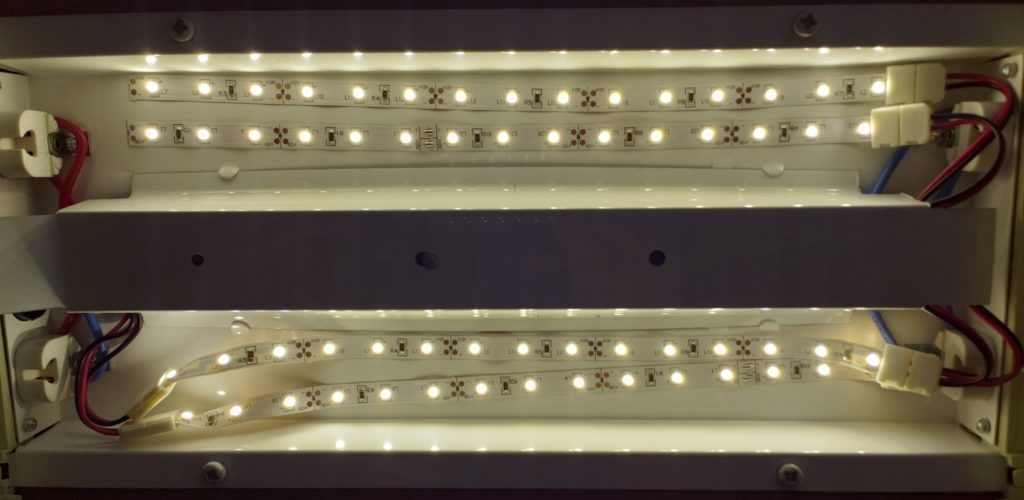
Using maximum amount of renewable resources meant getting rid of our hated Norcold 1200 or running on AC that required 8-10 kWh per day. Replacing with a very efficient residential refrigerator was a much better option. A real refrigerator provides space inside, cold ice cream and no fire hazard. We selected a Fisher & Paykel that has inverter driven pumps, no automatic ice maker or water cooler. This refrigerator uses less than 1.5 kWh on a normal day and is a major upgrade in use and look compared to the old fridge.
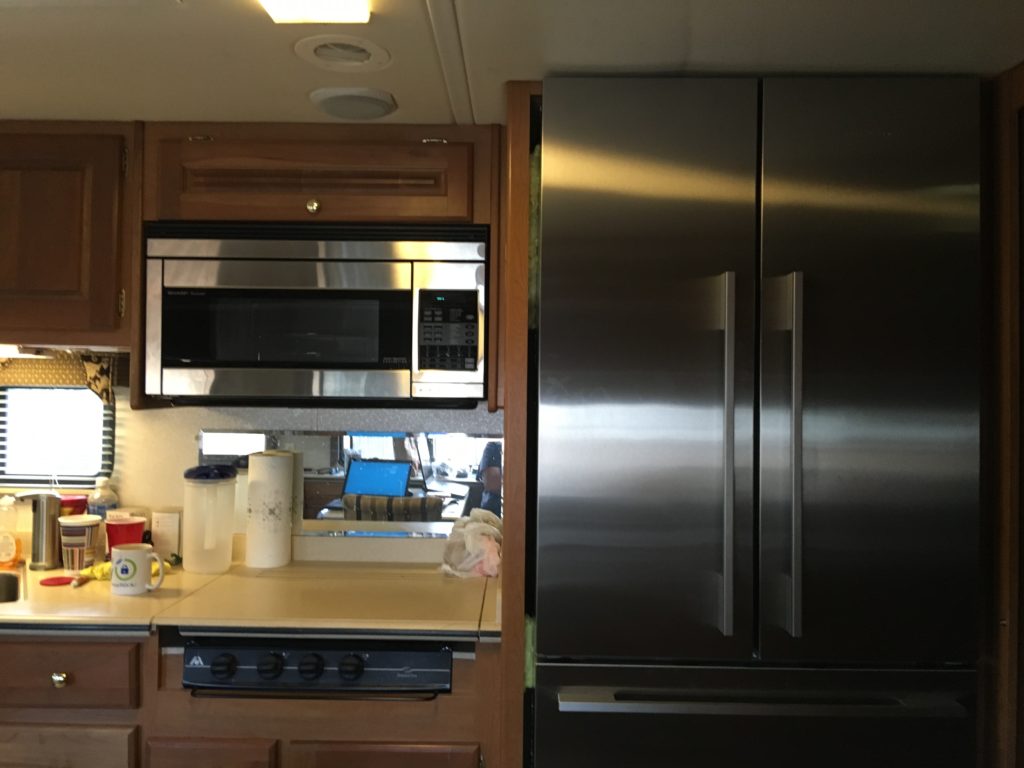
The other large consumer was the water heater. When running on power AC was 1400 Watt used and because of the poor insulation was it needed to heat the water every 3 hours. By adding insulation and using a step-down converter is the water heater now running every 8 hours and only using 400 Watt for a longer time. In the winter with low State of Charge can the propane still be used for heating water.
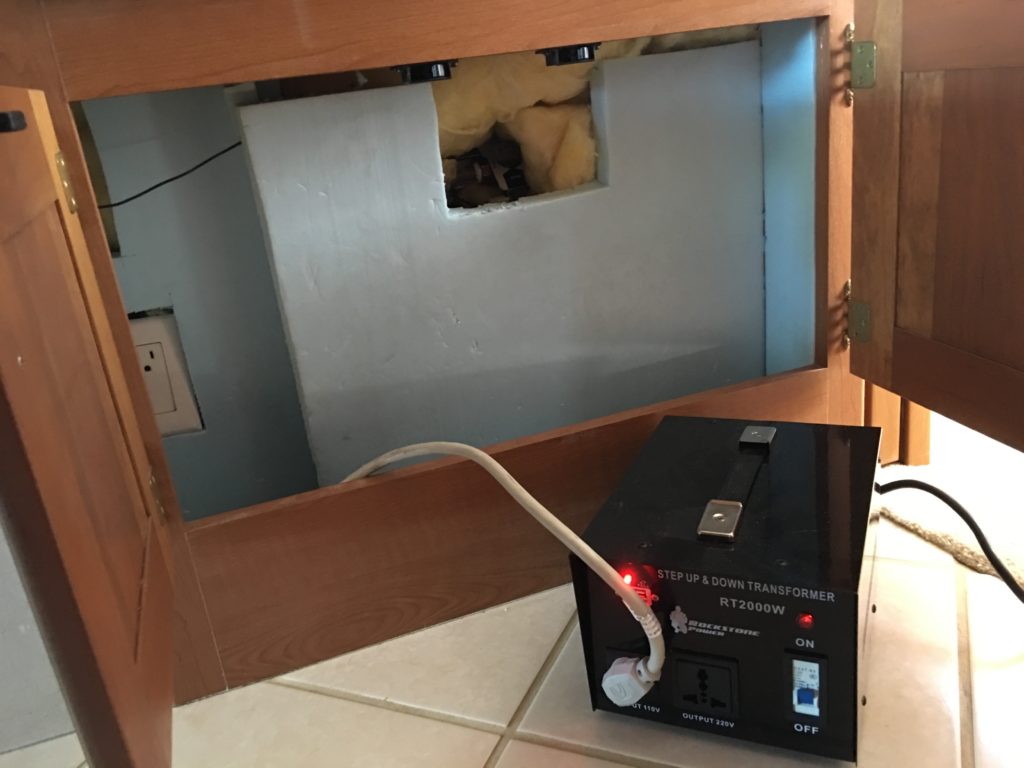
Conserving all the energy we could on regular appliances allow us to use 10-12 kWh on a regular day when we do not use our electric fireplace or roof air conditioners. The bigger consumers of electricity are listed below.
- Water Heater: 3-4 kWh
- Residential Refrigerator: 1-1.5 kWh
- Networking, Router, Video, and Music Server: 1 kWh
- Preparing Food: 1-2 kWh
- Computers and Phones for work: 0.5 kWh
- TVs, Fans and Light: <0.5 kWh
Energy Budget
We wanted to be able to last three days with bad weather. That would require 4 nights and 3 days with minimal charging, solar power is just covering the daytime usage. Even when completely overcast are Solar Panels producing 10-20% of maximum output. A typical night when we run all systems and the electric water heater is 6 kWh, without the water heater 4-5 kWh. So on bad days should we heat water with Propane when needed.
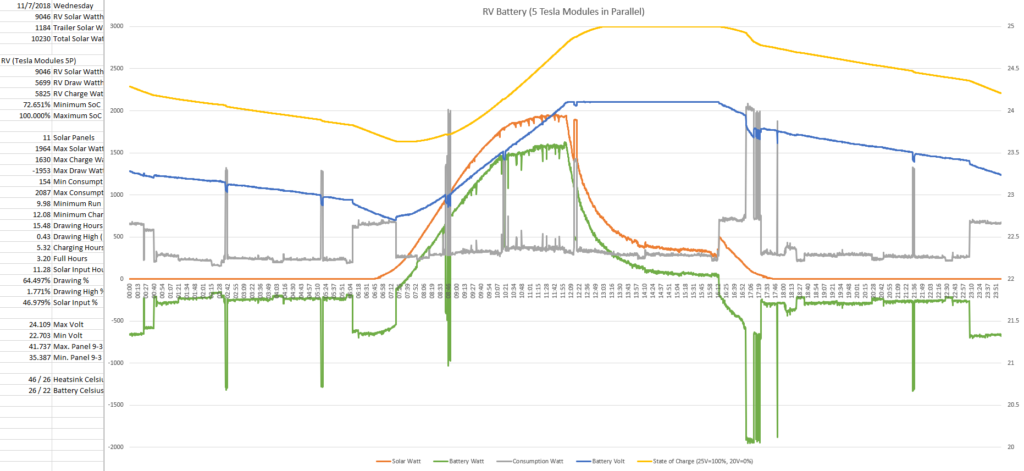
Allowing 5 kWh for nightly use require a battery pack with 20 kWh of useful energy storage. In that way can we last 4 night without depleting our battery. When we know the weather going to be bad in the winter we can for a few days try to conserve power until we reach a full charge. Conserving energy could stretch the available power to 5-6 days.
Solar Charging
With the wish to be able to live without the generator must the daily consumption be recharged by the sun. Using 10-12 kWh with the water heater and cooking on electric and 6-8 kWh without. This set the requirement for power generated by the sun in a single day. The amount of solar was designed based on a 10 kWh output on a sunny day on the shortest day of the year, staying in the Southwestern US. The Solar Electricity Handbook site is very helpful for this. It became clear pretty early that angling panels were not an option with the required number of panels and the weight.
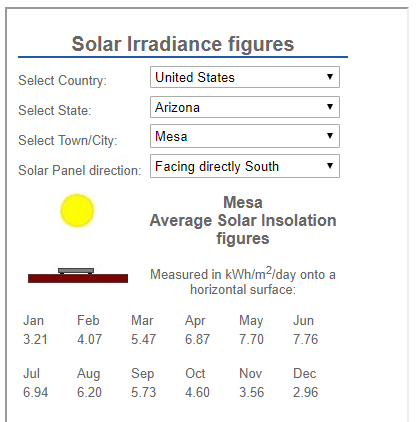
With 2.96 kWh per Square Meter or 0.27 kWh per Square Foot is it possible to calculate the required Area needed.
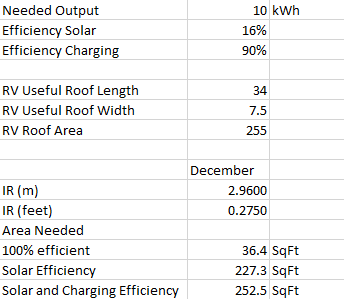
The Solar efficiency has to be calculated including the frame and looking at fitting the panels of the roof was it clear the more roof area was needed or the generator had to supply some power. With a trailer adding 70% more roof area and with no protruding vents or air conditioners can the roof be used more efficiently.
Looking at getting the maximum percentage of coverage on the roof and properly mounting panels was the longest panel the most efficient use of the space available. The 72 Cell solar panels are the longest around, with 6.5 feet. That reduced the available area on the RV and made it necessary to have addition roof space. The Jeep we have does not flat tow so the roof of the trailer was perfect for adding Solar Panels.
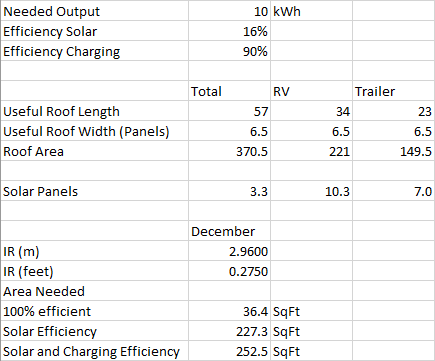
The 253 Square Feet needed can now be shared between trailer and RV so less of the possible roof space is needed on the RV and the solar panels can be mounted between the Air Conditioners. The hunt for a suitable Solar Panel made SolarWorld XL 345 Watt the best option. With a width of 3.3 feet can 10 solar panels fit on the RV and 7 solar panels on the trailer. Without covering the Air Conditioners could 6 solar panels fit on the RV. This provides 13 x 345 Watt maximum or 4485 Watt of solar panels from 279 Square Feet. The theoretical output is 11 kWh that is matching closely to what we have seen.
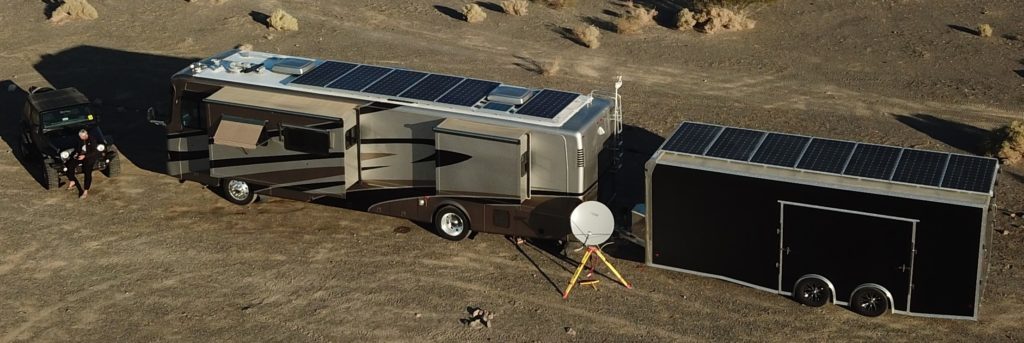
Handling all that Solar power requires multiple large controllers. Using MPPT controllers that provide 10% more power with matched solar panels and with large residential panels allow converting Power to Power independent of the Volts was mandatory. The MorningStar TriStar MPPT-60 provided the features we needed without having fans that can fail or create noise. Two controllers can handle 120 Ampere maximum output, with a 24 Volt battery is this a maximum of 2880 Watt. The total capacity of Solar Panels exceeds this in the middle of the day in the summer. But we design for the short days with low sun and not for maximum output that we cannot use anyway. In the winter is the maximum output from a Solar Panel mounted flat ~60% of the maximum output.
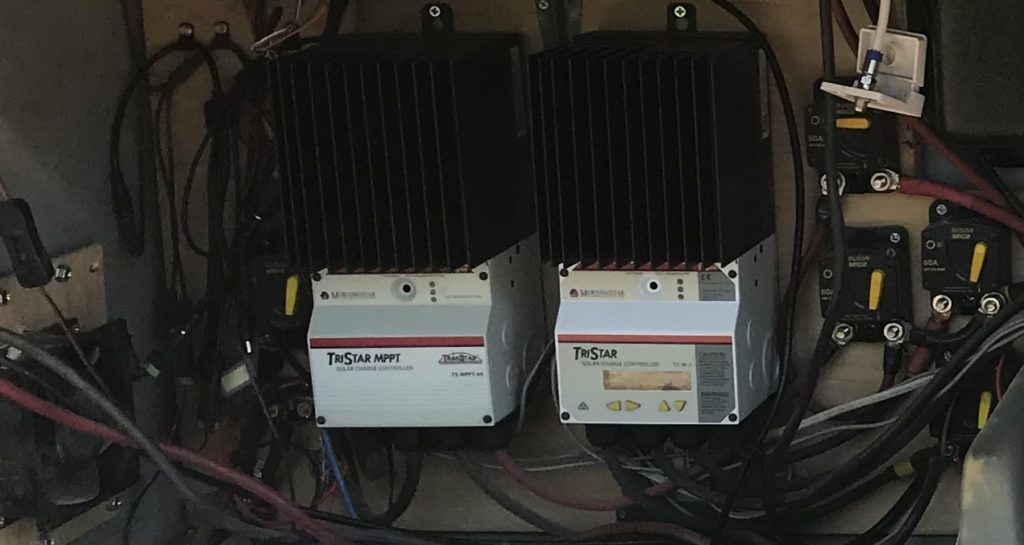
The Power from the trailer is transferred as DC directly to the RV with a 6 Gauge wire. This wire can be disconnected with an Anderson connector.
Generating AC Power
We had been living for a while with a 2000 Watt, 12 Volt based Inverter. This was a problem with many loads being 80-100% of the capacity. A stronger inverter was needed and switching to 2800-3000 Watt 12 Volt Inverters did not really provide a lot of extra room plus the DC wiring was already stressed with 200+ Ampere going between batteries and Inverter. The solution was to change to higher Battery Volt in the House Batteries. Going 24 Volt (4000 Watt Inverter) or 48 Volt (4400 Watt Inverter) was the options. Looking at charging (Solar Panel Volt should be higher than Battery Volt for most controllers) and the general safety was 24 Volt enough to solve the problem with too low AC capacity and very thick wires. A Magnum MS4024 replaced the original Inverter. Our original inverter had two 20 Ampere breakers built in, we had to add an external breaker box for this. But at the same time could we also add an extra control that disconnected power based on the Battery Volt, we use this for our Fireplace and Air Conditioning that cannot drain more than 40% of the stored energy.
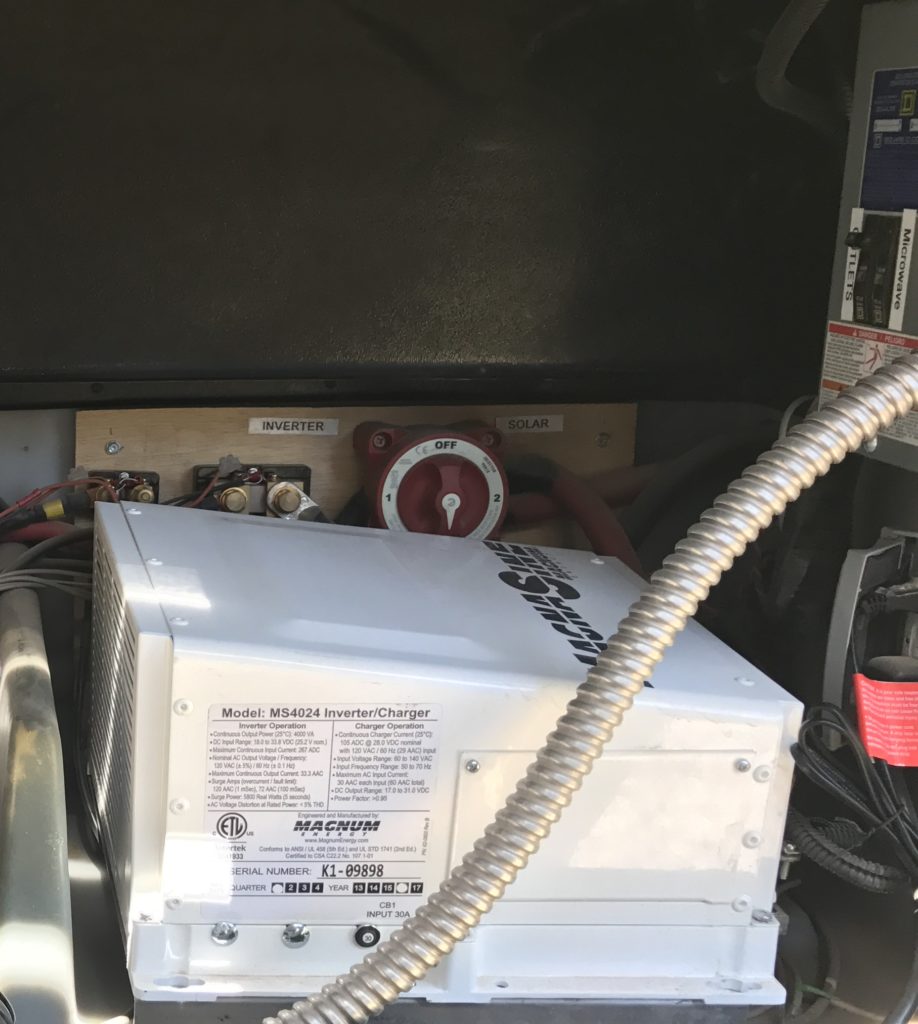
Switching the House Battery to 24 Volt solved the 120 Volt AC problems, but left a new issue with running lights, fans, and sensors that all require 12 Volt. A Samlex DC to DC converter is now providing the 12 Volt for the House with the benefit of always having the same 13.6 Volt and fans running the same speed.
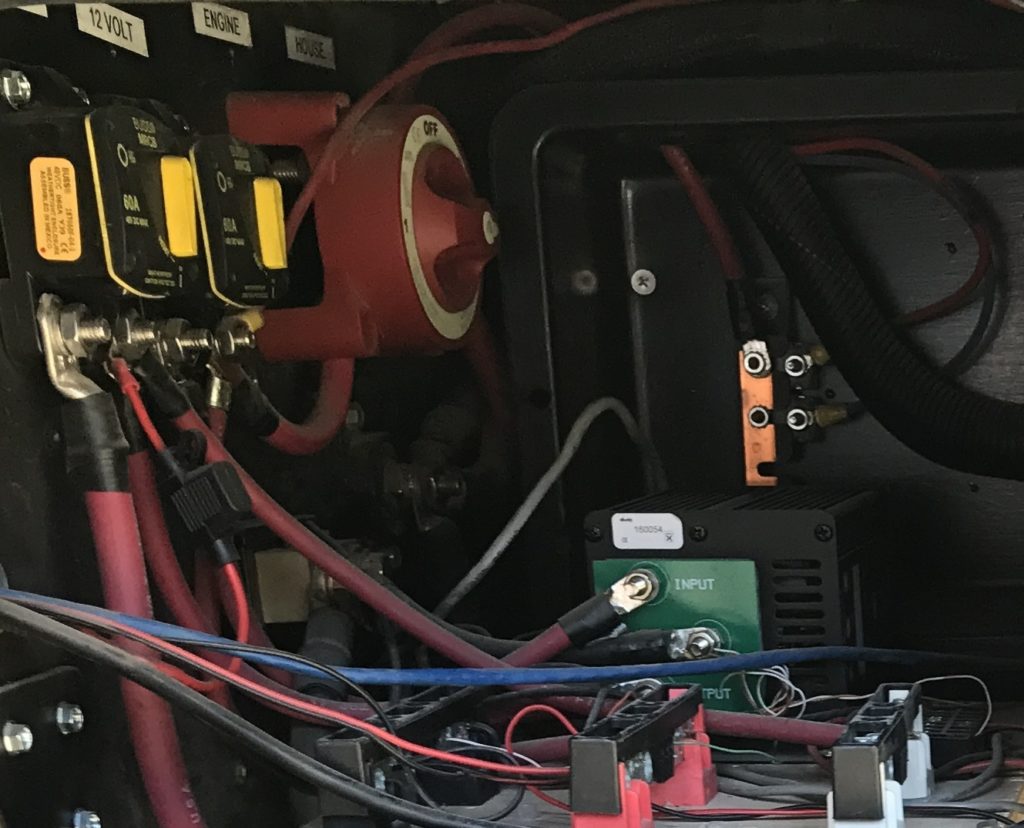
Two very high loads with over 200 Ampere (Starting Generator and Hydraulic Leveling) is running directly from the Engine Battery that is 12 Volt.
House Battery
Space and weight are premium in an RV and we did not want to use the room inside or other storage bays for batteries. The total space we had available was the room for the original 8 Golf Cart batteries weighing 530 pounds. Using Lead Acid Batteries is the maximum capacity 8 x 6 Volt x 235 AH = 11.3 kWh, but only 50% is useful for 5.6 kWh, that is not enough. To get to 20 kWh of stored energy would 28 batteries be required with a weight of 1850 pounds.
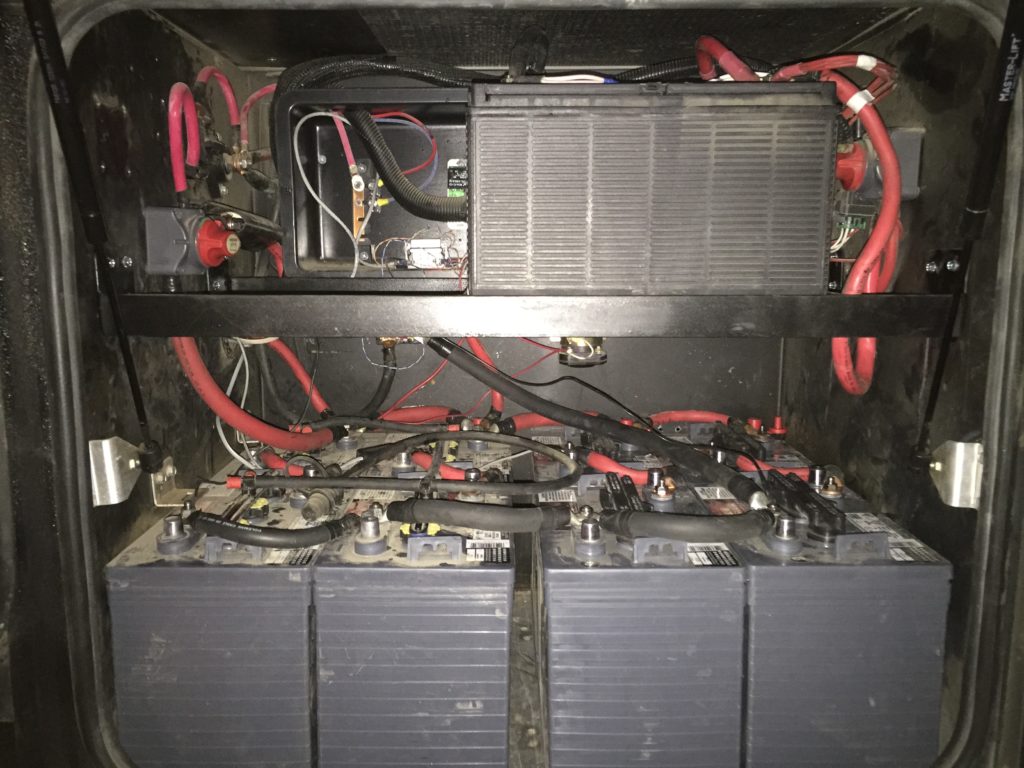
Using Battleborn Lithium batteries allow 6 x 13 Volt x 100 AH = 7.8 kWh with 90% useful for 7.0 kWh useful that is not enough either for 3 days, but would provide 2 nights of energy. Battleborn Batteries does not gas and is very safe so extra batteries could have been stored inside. A total of 18 Battleborn batteries with a weight of 600 pounds could provide the needed energy storage.

The Tesla modules from the Model S have a size that can fit in a typical RV battery box, is relatively light and very energy dense. Each module is 24 Volt, 3 inches thick and matches the Inverter well. But the problem is, of course, this is a part of a car that makes it safe and useful. In the battery box was their room enough for 5 modules with 5.3 kWh each for a total capacity of 26.5 kWh. If a Lithium battery is used to the maximum range is it allowing very little for safety and also reduce the cycles the battery last. The Tesla modules in our house battery are used from 24.2 Volt to 20 Volt using ~80% of the useful capacity for 21 kWh of useful storage with a weight of 300 pounds.
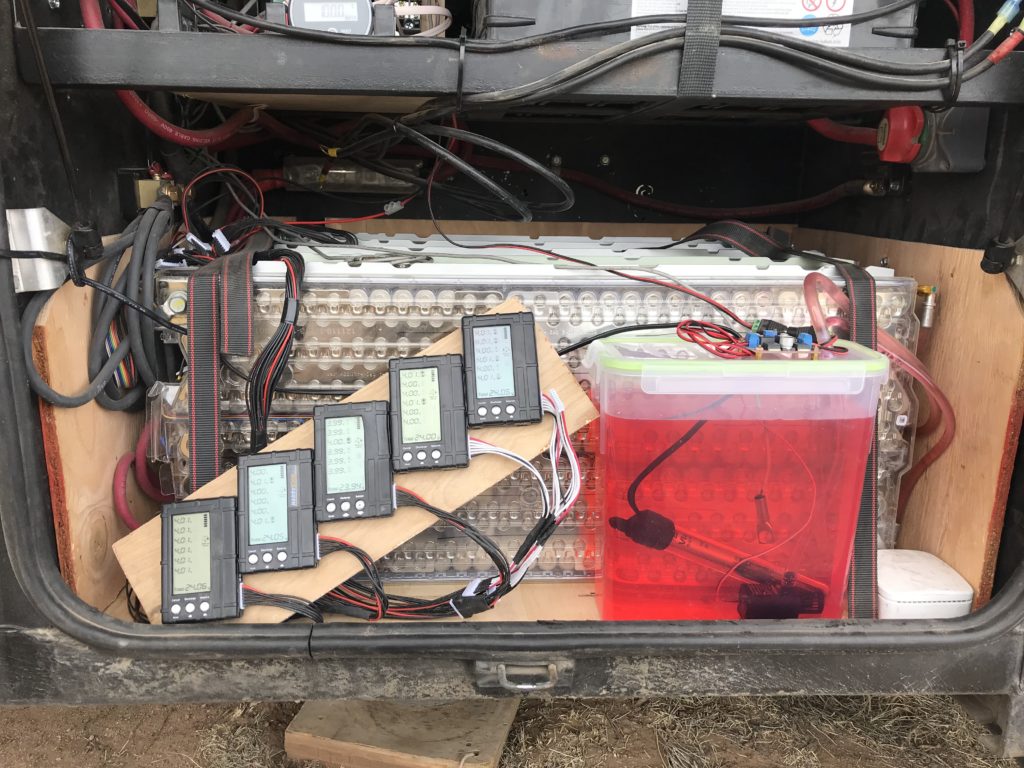
Essential for using Lithium batteries is to control the temperature during charging. If a Lithium battery is charged below freezing temperatures is the battery damaged and can also be very unsafe when recharged later. The Tesla car has fluid that circulates through the Battery pack and this can be used for temperature control. A small aquarium pump and heather ensure that the battery never gets below 60 Fahrenheit even in freezing weather. Lining the battery box with 1/4 inch plywood is providing both electric and thermal insulation.

With Lithium batteries having more than 99% charge efficiency is no current bleeding through, like a Lead Acid, without increasing the Volt in a cell. It is essential to use Lithium batteries with a solution that balance the cells during charging since more than 4.2 Volt per cell is dangerous and causes damage. The Hobbyking Battery Medic is capable of balancing the cell when Volt is above a certain level. The balancing is quite simple by simply adding a small resistor in parallel if the Volt is more than 0.01 Volt higher in one cell, balancing every day ensure only a short time is needed and minimal energy is lost.